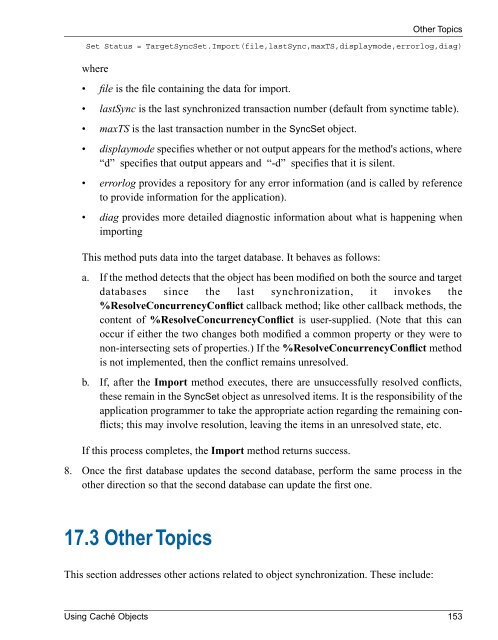Using Caché Objects - InterSystems Documentation
Using Caché Objects - InterSystems Documentation
Using Caché Objects - InterSystems Documentation
Create successful ePaper yourself
Turn your PDF publications into a flip-book with our unique Google optimized e-Paper software.
Set Status = TargetSyncSet.Import(file,lastSync,maxTS,displaymode,errorlog,diag)<br />
where<br />
• file is the file containing the data for import.<br />
• lastSync is the last synchronized transaction number (default from synctime table).<br />
• maxTS is the last transaction number in the SyncSet object.<br />
• displaymode specifies whether or not output appears for the method's actions, where<br />
“d” specifies that output appears and “-d” specifies that it is silent.<br />
• errorlog provides a repository for any error information (and is called by reference<br />
to provide information for the application).<br />
• diag provides more detailed diagnostic information about what is happening when<br />
importing<br />
This method puts data into the target database. It behaves as follows:<br />
a. If the method detects that the object has been modified on both the source and target<br />
databases since the last synchronization, it invokes the<br />
%ResolveConcurrencyConflict callback method; like other callback methods, the<br />
content of %ResolveConcurrencyConflict is user-supplied. (Note that this can<br />
occur if either the two changes both modified a common property or they were to<br />
non-intersecting sets of properties.) If the %ResolveConcurrencyConflict method<br />
is not implemented, then the conflict remains unresolved.<br />
b. If, after the Import method executes, there are unsuccessfully resolved conflicts,<br />
these remain in the SyncSet object as unresolved items. It is the responsibility of the<br />
application programmer to take the appropriate action regarding the remaining conflicts;<br />
this may involve resolution, leaving the items in an unresolved state, etc.<br />
If this process completes, the Import method returns success.<br />
Other Topics<br />
8. Once the first database updates the second database, perform the same process in the<br />
other direction so that the second database can update the first one.<br />
17.3 Other Topics<br />
This section addresses other actions related to object synchronization. These include:<br />
<strong>Using</strong> <strong>Caché</strong> <strong>Objects</strong> 153

















